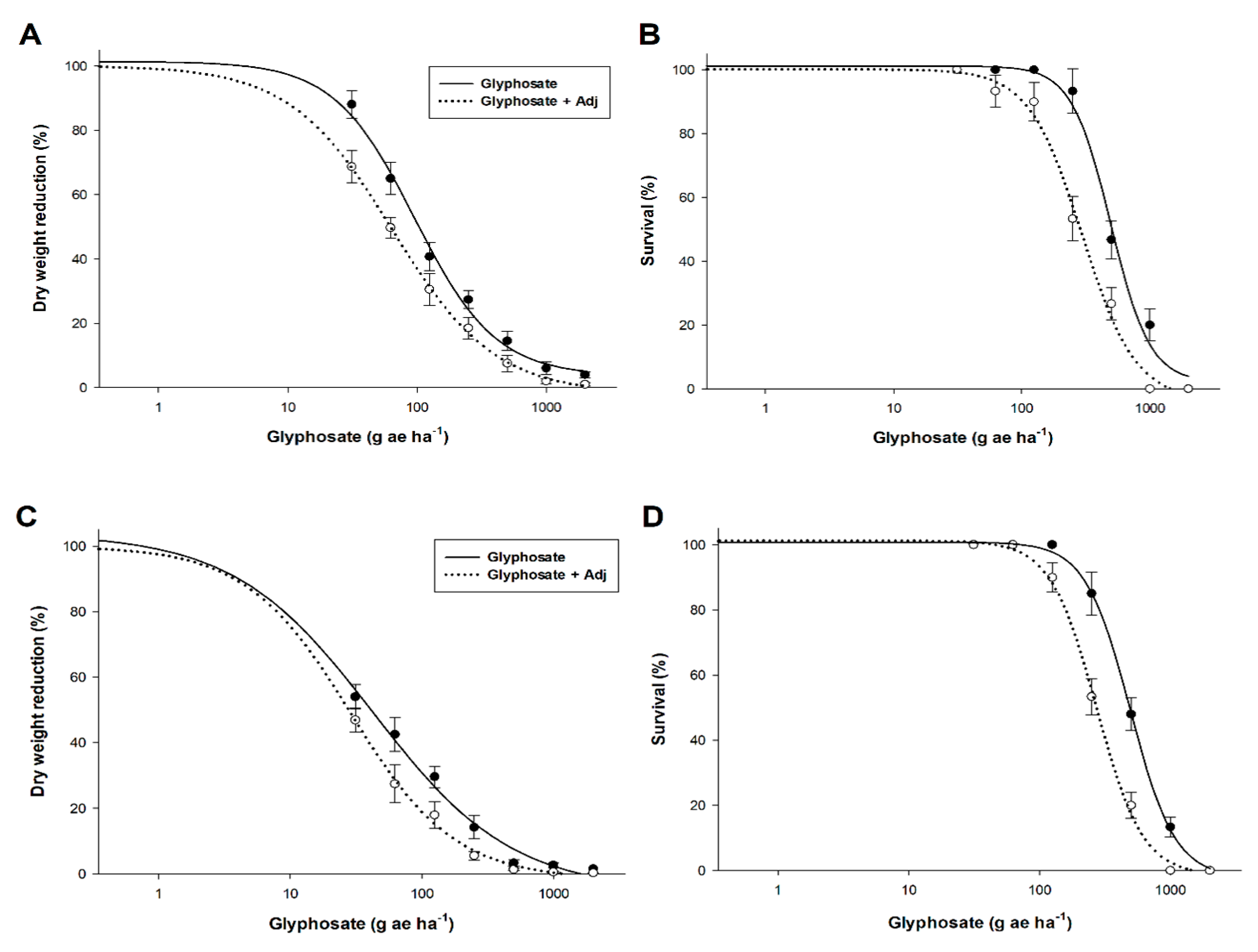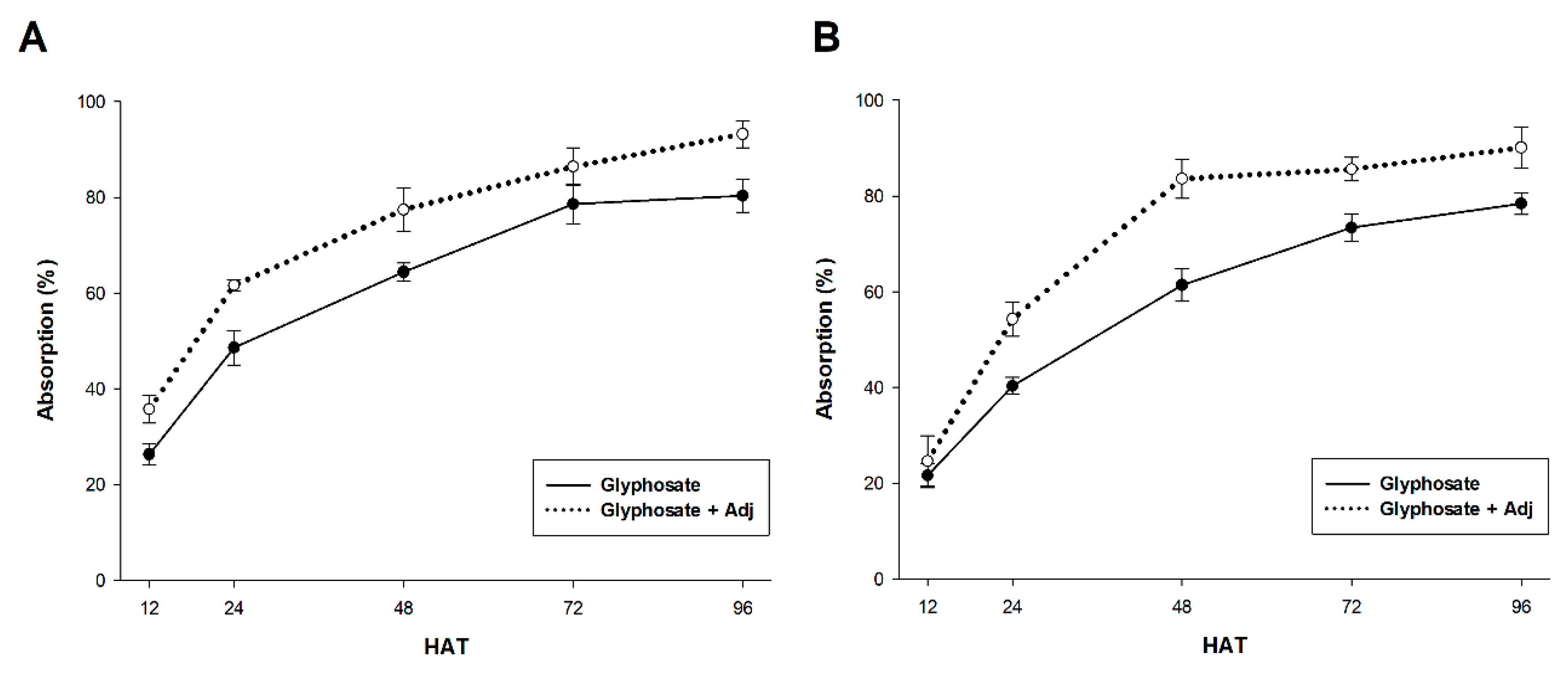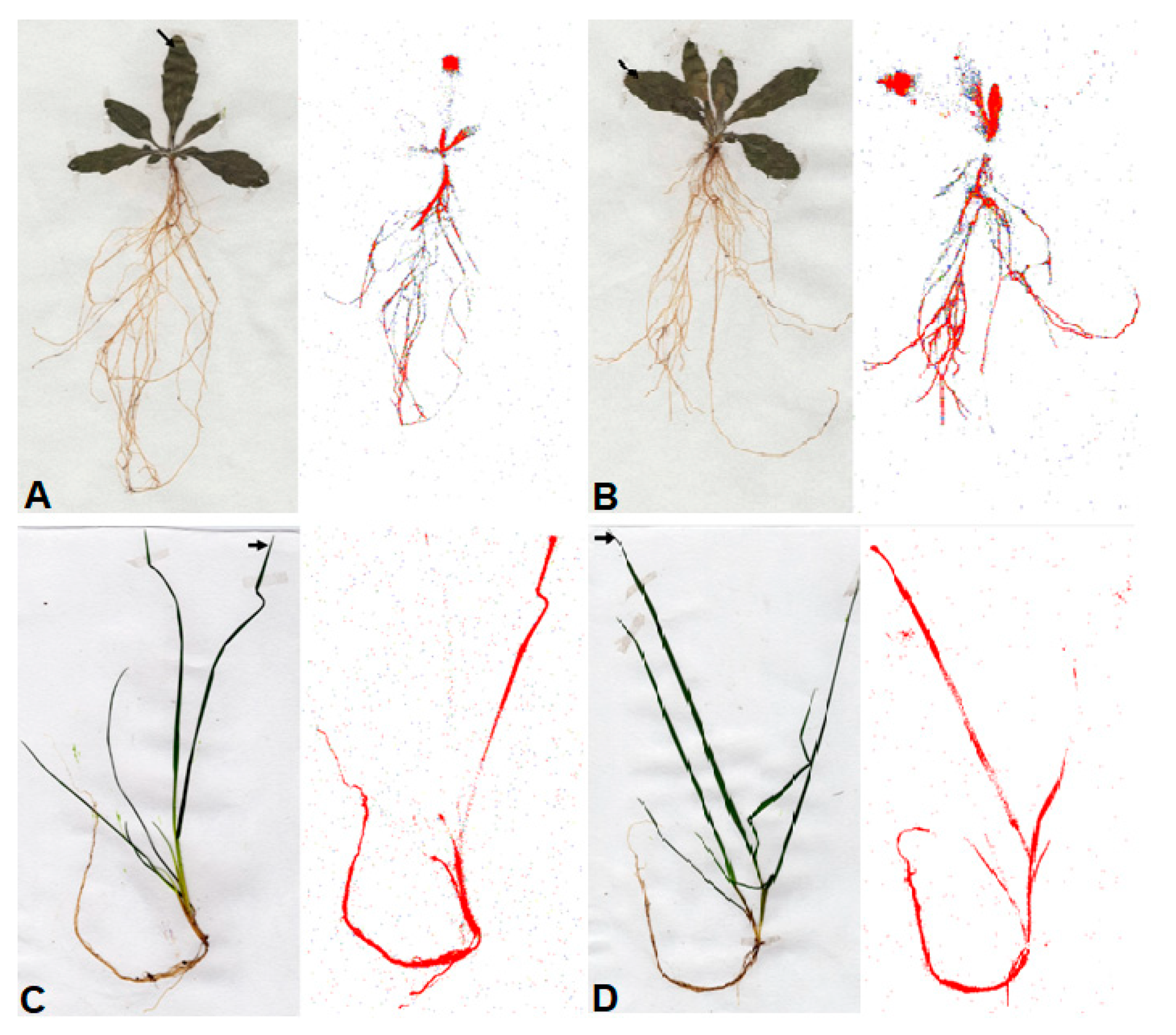Effect of Adjuvant on Glyphosate Effectiveness, Retention, Absorption and Translocation in Lolium rigidum and Conyza canadensis
Abstract
1. Introduction
2. Results
2.1. Dose–Response Assay
2.2. Spray Retention Assays
2.3. 14C-Glyphosate Absorption and Translocation
3. Discussion
4. Materials and Methods
4.1. Chemical
4.2. Plant Material
4.3. Dose–Response Assay
4.4. Spray Retention and Contact Angle Assays
4.5. 14C-Glyfosate Absorption and Translocation
4.6. Data Analysis
5. Conclusions
Author Contributions
Funding
Conflicts of Interest
References
- Castro, M.J.L.; Ojeda, C.; Cirelli, A.F. Advances in surfactants for agrochemicals. Environ. Chem. Lett. 2014, 12, 85–95. [Google Scholar] [CrossRef]
- Travlos, I.; Cheimona, N.; Dimitrios, B. Glyphosate efficacy of different salt formulations and adjuvant additives on various weeds. Agronomy 2017, 7, 60. [Google Scholar] [CrossRef]
- Leaper, C.; Holloway, P.J. Adjuvants and glyphosate activity. Pest Manag. Sci. 2000, 56, 313–319. [Google Scholar] [CrossRef]
- Zulet-González, A.; Fernández-Escalada, M.; Zabalza, A.; Royuela, M. Enhancement of glyphosate efficacy on Amaranthus palmeri by exogenous quinate application. Pestic. Biochem. Physiol. 2019, 158, 1–11. [Google Scholar] [CrossRef] [PubMed]
- Heap, I. The International Survey of Herbicide Resistant Weeds. Available online: http://www.weedscience.org (accessed on 10 February 2020).
- Li, H.; Travlos, I.; Qi, L.; Kanatas, P.; Wang, P. Optimization of herbicide use: Study on spreading and evaporation characteristics of glyphosate-organic silicone mixture droplets on weed leaves. Agronomy 2019, 9, 547. [Google Scholar] [CrossRef]
- Hunsche, M.; Noga, G. Effects of relative humidity and substrate on the spatial association between glyphosate and ethoxylated seed oil adjuvants in the dried deposits of sessile droplets. Pest Manag. Sci. 2012, 68, 231–239. [Google Scholar] [CrossRef]
- Ramsey, R.J.L.; Stephenson, G.R.; Hall, J.C. A review of the effects of humidity, humectants, and surfactant composition on the absorption and efficacy of highly water-soluble herbicides. Pestic. Biochem. Physiol. 2005, 82, 162–175. [Google Scholar] [CrossRef]
- Räsch, A.; Hunsche, M.; Mail, M.; Burkhardt, J.; Noga, G.; Pariyar, S. Agricultural adjuvants may impair leaf transpiration and photosynthetic activity. Plant Physiol. Biochem. 2018, 132, 229–237. [Google Scholar] [CrossRef]
- Hao, Y.; Zhang, N.; Xu, W.; Gao, J.; Zhang, Y.; Tao, L. A natural adjuvant shows the ability to improve the effectiveness of glyphosate application. J. Pestic. Sci. 2019, 44, 106–111. [Google Scholar] [CrossRef]
- Appah, S.; Jia, W.; Ou, M.; Wang, P.; Asante, E.A. Analysis of potential impaction and phytotoxicity of surfactant-plant surface interaction in pesticide application. Crop Prot. 2020, 127, 104961. [Google Scholar] [CrossRef]
- Dong, X.; Zhu, H.; Yang, X. Characterization of droplet impact and deposit formation on leaf surfaces. Pest Manag. Sci. 2015, 71, 302–308. [Google Scholar] [CrossRef] [PubMed]
- Fernández-Moreno, P.T.; Bastida, F.; De Prado, R. Evidence, Mechanism and alternative chemical seedbank-level control of glyphosate resistance of a rigid ryegrass (Lolium rigidum) biotype from southern Spain. Front. Plant Sci. 2017, 8, 450. [Google Scholar] [CrossRef] [PubMed]
- Travlos, I.; Cheimona, N.; De Prado, R.; Jhala, A.; Chachalis, D.; Tani, E. First case of glufosinate-resistant rigid ryegrass (Lolium rigidum Gaud.) in Greece. Agronomy 2018, 8, 35. [Google Scholar] [CrossRef]
- Goggin, D.E.; Powles, S.B.; Steadman, K.J. Understanding Lolium rigidum Seeds: The Key to Managing a Problem Weed? Agronomy 2012, 2, 222–239. [Google Scholar] [CrossRef]
- González-Torralva, F.; Cruz-Hipolito, H.; Bastida, F.; Mülleder, N.; Smeda, R.J.; De Prado, R. Differential susceptibility to glyphosate among the Conyza weed species in Spain. J. Agric. Food Chem. 2010, 58, 4361–4366. [Google Scholar] [CrossRef]
- Travlos, I.S.; Chachalis, D. Assessment of glyphosate-resistant horseweed (Conyza canadensis L. Cronq.) and fleabane (Conyza albida Willd. ex Spreng) populations from perennial crops in Greece. Int. J. Plant Prod. 2013, 7, 665–676. [Google Scholar]
- Zaplata, M.K.; Winter, S.; Biemelt, D.; Fischer, A. Immediate shift towards source dynamics: The pioneer species Conyza canadensis in an initial ecosystem. Flora Morphol. Distrib. Funct. Ecol. Plants 2011, 206, 928–934. [Google Scholar] [CrossRef]
- Nandula, V.K.; Eubank, T.W.; Poston, D.H.; Koger, C.H.; Reddy, K.N. Factors affecting germination of horseweed (Conyza canadensis). Weed Sci. 2006, 54, 898–902. [Google Scholar] [CrossRef]
- De Ruiter, H.; Uffing, A.J.M.; Meinen, E.; Prins, A. Influence of Surfactants and Plant Species on Leaf Retention of Spray Solutions. Weed Sci. 1990, 38, 567–572. [Google Scholar] [CrossRef]
- Chachalis, D.; Reddy, K.N.; Elmore, C.D.; Steele, M.L. Herbicide efficacy, leaf structure, and spray droplet contact angle among Ipomoea species and smallflower morningglory. Weed Sci. 2001, 49, 628–634. [Google Scholar] [CrossRef]
- Lin, H.; Zhou, H.; Xu, L.; Zhu, H.; Huang, H. Effect of surfactant concentration on the spreading properties of pesticide droplets on Eucalyptus leaves. Biosyst. Eng. 2016, 143, 42–49. [Google Scholar] [CrossRef]
- Holloway, P.J. Surface factors affecting the wetting of leaves. Pestic. Sci. 1970, 1, 156–163. [Google Scholar] [CrossRef]
- Zhu, F.; Cao, C.; Cao, L.; Li, F.; Du, F.; Huang, Q. Wetting Behavior and Maximum Retention of Aqueous Surfactant Solutions on Tea Leaves. Molecules 2019, 24, 2094. [Google Scholar] [CrossRef] [PubMed]
- Gaskin, R.E.; Steele, K.D.; Forster, W.A. Characterising plant surfaces for spray adhesion and retention. N. Z. Plant Prot. 2005, 58, 179–183. [Google Scholar] [CrossRef]
- Damak, M.; Mahmoudi, S.R.; Hyder, M.N.; Varanasi, K.K. Enhancing droplet deposition through in-situ precipitation. Nat. Commun. 2016, 7, 12560. [Google Scholar] [CrossRef]
- He, Y.; Xiao, S.; Wu, J.; Fang, H. Influence of Multiple Factors on the Wettability and Surface Free Energy of Leaf Surface. Appl. Sci. 2019, 9, 593. [Google Scholar] [CrossRef]
- Law, K.-Y. Definitions for Hydrophilicity, Hydrophobicity, and Superhydrophobicity: Getting the Basics Right. J. Phys. Chem. Lett. 2014, 5, 686–688. [Google Scholar] [CrossRef]
- Appah, S.; Zhou, H.; Wang, P.; Ou, M.; Jia, W. Charged monosized droplet behaviour and wetting ability on hydrophobic leaf surfaces depending on surfactant-pesticide concentrate formulation. J. Electrostat. 2019, 100, 103356. [Google Scholar] [CrossRef]
- Menendez, J.; Camacho, D.; Fernandez-Cerejido, M.C.; Bastida, F. Effect of tank-mixed blended green adjuvants on glyphosate efficacy in four winter crop weed species. Weed Res. 2011, 51, 344–352. [Google Scholar] [CrossRef]
- Zheng, L.; Cao, C.; Cao, L.; Chen, Z.; Huang, Q.; Song, B. Bounce behavior and regulation of pesticide solution droplets on rice leaf surfaces. J. Agric. Food Chem. 2018, 66, 11560–11568. [Google Scholar] [CrossRef]
- Niedobová, J.; Skalský, M.; Ouředníčková, J.; Michalko, R.; Bartošková, A. Synergistic effects of glyphosate formulation herbicide and tank-mixing adjuvants on Pardosa spiders. Environ. Pollut. 2019, 249, 338–344. [Google Scholar] [CrossRef] [PubMed]
- Haefs, R.; Schmitz-Eiberger, M.; Mainx, H.-G.; Mittelstaedt, W.; Noga, G. Studies on a new group of biodegradable surfactants for glyphosate. Pest Manag. Sci. 2002, 58, 825–833. [Google Scholar] [CrossRef] [PubMed]
- Amaro-Blanco, I.; Fernández-Moreno, P.T.; Osuna-Ruiz, M.D.; Bastida, F.; De Prado, R. Mechanisms of glyphosate resistance and response to alternative herbicide-based management in populations of the three Conyza species introduced in southern Spain. Pest Manag. Sci. 2018, 74, 1925–1937. [Google Scholar] [CrossRef] [PubMed]
- Hess, M.; Barralis, G.; Bleiholder, H.; Buhr, L.; Eggers, T.; Hack, H.; Stauss, R. Use of the extended BBCH scale—General for the descriptions of the growth stages of mono- and dicotyledonous weed species. Weed Res. 1997, 37, 433–441. [Google Scholar] [CrossRef]
- Ritz, C.; Baty, F.; Streibig, J.C.; Gerhard, D. Dose-Response Analysis Using R. PLoS ONE 2015, 10, e0146021. [Google Scholar] [CrossRef]



| GR50 | ||||||
| Species | Treatment | b | d | GR50 (g ae ha−1) | P-value | IE |
| C. canadensis | Glyphosate | 1.56 | 100.88 | 95.86 ± 5.98 | <0.001 | - |
| Glyphosate + Adj | 0.96 | 98.99 | 72.64 ± 6.99 | <0.001 | 24.22 | |
| L. rigidum | Glyphosate | 0.99 | 100.99 | 36.56 ± 3.99 | <0.001 | - |
| Glyphosate + Adj | 1.03 | 98.86 | 28.18 ± 3.32 | <0.001 | 22.92 | |
| LD50 | ||||||
| Species | Treatment | b | d | LD50 (g ae ha−1) | P-value | IE |
| C. canadensis | Glyphosate | 2.81 | 96.38 | 493.89±16.52 | <0.001 | - |
| Glyphosate + Adj | 2.38 | 101.68 | 283.06±18.22 | <0.001 | 42.52 | |
| L. rigidum | Glyphosate | 3.45 | 100.56 | 468.98±23.87 | <0.001 | - |
| Glyphosate + Adj | 2.69 | 100.99 | 275.88±17.06 | <0.001 | 41.17 | |
| Species | Treatment | Foliar retention (µL spraying sol. g-1dry matter)a | Contact angle (deg)a |
|---|---|---|---|
| C. canadensis | Glyphosate | 350.42b | 73.65a |
| Glyphosate + Adj | 515.60a | 65.43b | |
| L. rigidum | Glyphosate | 307.23b | 74.10a |
| Glyphosate + Adj | 438.60a | 67.80b |
| Species | Treatment | Absorption (%)a | Translocation (% 14C-absorbed)b y c | ||
|---|---|---|---|---|---|
| TL | RP | RS | |||
| C. canadensis | Glyphosate | 80.31±3.40b | 34.57±1.31a | 31.51±2.69a | 33.92±3.17a |
| Glyphosate + Adj | 93.22±1.47a | 30.61±2.40b | 32.38±1.92a | 37.01±2.18a | |
| L. rigidum | Glyphosate | 78.48±2.39b | 37.97±2.15a | 29.64±1.83a | 32.39±2.68b |
| Glyphosate + Adj | 90.56±2.45a | 28.65±1.82b | 32.39±1.17a | 38.96±1.75a | |
© 2020 by the authors. Licensee MDPI, Basel, Switzerland. This article is an open access article distributed under the terms and conditions of the Creative Commons Attribution (CC BY) license (http://creativecommons.org/licenses/by/4.0/).
Share and Cite
Palma-Bautista, C.; Vazquez-Garcia, J.G.; Travlos, I.; Tataridas, A.; Kanatas, P.; Domínguez-Valenzuela, J.A.; De Prado, R. Effect of Adjuvant on Glyphosate Effectiveness, Retention, Absorption and Translocation in Lolium rigidum and Conyza canadensis. Plants 2020, 9, 297. https://doi.org/10.3390/plants9030297
Palma-Bautista C, Vazquez-Garcia JG, Travlos I, Tataridas A, Kanatas P, Domínguez-Valenzuela JA, De Prado R. Effect of Adjuvant on Glyphosate Effectiveness, Retention, Absorption and Translocation in Lolium rigidum and Conyza canadensis. Plants. 2020; 9(3):297. https://doi.org/10.3390/plants9030297
Chicago/Turabian StylePalma-Bautista, Candelario, Jose G. Vazquez-Garcia, Ilias Travlos, Alexandros Tataridas, Panagiotis Kanatas, José A. Domínguez-Valenzuela, and Rafael De Prado. 2020. "Effect of Adjuvant on Glyphosate Effectiveness, Retention, Absorption and Translocation in Lolium rigidum and Conyza canadensis" Plants 9, no. 3: 297. https://doi.org/10.3390/plants9030297
APA StylePalma-Bautista, C., Vazquez-Garcia, J. G., Travlos, I., Tataridas, A., Kanatas, P., Domínguez-Valenzuela, J. A., & De Prado, R. (2020). Effect of Adjuvant on Glyphosate Effectiveness, Retention, Absorption and Translocation in Lolium rigidum and Conyza canadensis. Plants, 9(3), 297. https://doi.org/10.3390/plants9030297









